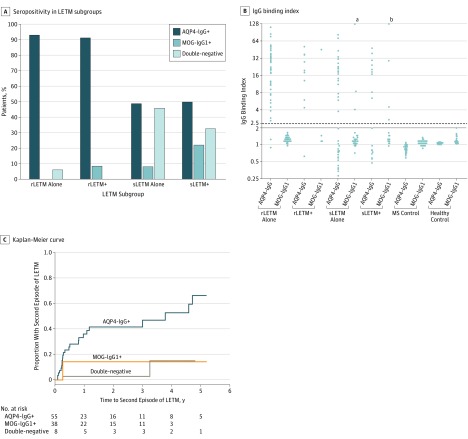Figure. Seroprevalence and Outcome of Longitudinally Extensive Transverse Myelitis (LETM) Stratified According to Aquaporin 4 (AQP4) and Myelin Oligodendrocyte Glycoprotein IgG (MOG-IgG) Serostatus.
A, Frequency of AQP4-IgG and MOG-IgG1 seropositivity in LETM subgroups. B, IgG binding index of AQP4-IgG and MOG-IgG1 stratified according to disease and control subgroups: recurrent longitudinally extensive transverse myelitis (rLETM alone), rLETM with subsequent other demyelinating attacks (rLETM+), single-episode longitudinally extensive transverse myelitis (sLETM alone), sLETM with subsequent other demyelinating attacks (sLETM+), multiple sclerosis (MS), and healthy controls. The IgG binding index cut point of positivity of M1-AQP4-IgG was 2 (solid line) and of MOG-IgG1 was 2.5 (dashed line).4 C, Kaplan-Meier curve estimates of years from the first episode of LETM to second episode. All patients with sLETM as onset attack between 2008 and 2017 seen at Mayo Clinic were included and analyzed. Five years after the first episode of LETM, a second episode of LETM was estimated to occur in a significantly higher proportion of AQP4-IgG–positive patients (66%) compared with double-seronegative (15%) and MOG-IgG1–positive patients (14%) (P < .001).
aThe IgG binding index value for this individual is 280.
bThe IgG binding index value for this individual is 190.

